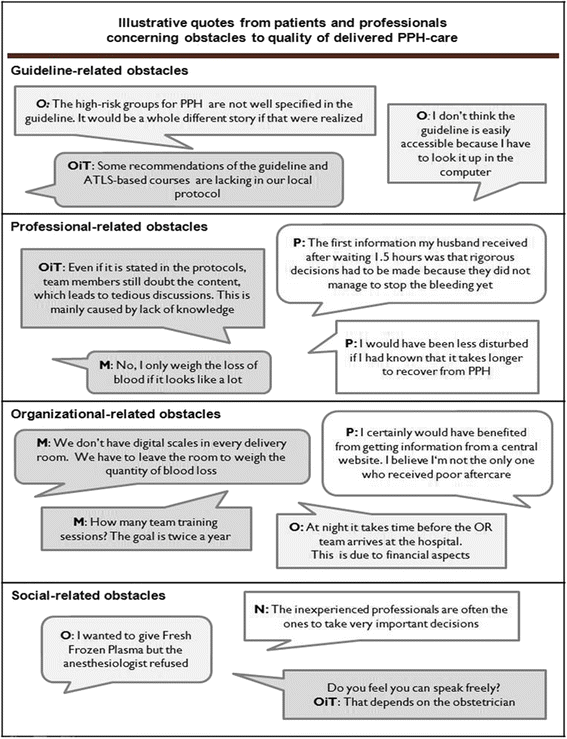Influencing factors for high quality care on postpartum haemorrhage in the Netherlands: patient and professional perspectives
- PMID: 26497307
- PMCID: PMC4619207
- DOI: 10.1186/s12884-015-0707-9
Influencing factors for high quality care on postpartum haemorrhage in the Netherlands: patient and professional perspectives
Abstract
Background: Postpartum haemorrhage (PPH) remains a major contributor to maternal morbidity even in high resource settings, despite the development and dissemination of evidence-based guidelines and Advance-Trauma-Life-Support (ATLS) based courses for optimal management of PPH. We aimed to assess current influencing factors (obstacles and facilitators) for the delivery of high quality PPH-care from both patient and professional perspective.
Methods: We qualitatively explored influencing factors for delivering high quality PPH-care, by having individual interviews with PPH-patients and focus group interviews with the different types of professionals working in the delivery room. For both perspectives, the theoretical frameworks of Grol and Cabana were used to classify the influencing factors for optimal PPH-care (factors of the guidelines, of professionals, of patients, of the social setting and of the organisation). In order to assess the importance of the influencing factors found among the professionals, we quantified these factors in a web-based questionnaire.
Results: A total of 12 patients and 41 professionals participated in the interviews, and 315 complete surveys were analyzed. The main obstacle for high quality PPH-care identified by patients was the lack of information given by the professionals to the patient and partner before, during and after the PPH event. An informative patient website, a patient leaflet and a follow-up consultation were mentioned as facilitators. The main obstacles according to the professionals were: lack of clarity of the guidelines, lack of knowledge and failing team-communication. Team training and checklists/ flowcharts were considered facilitators.
Conclusions: Different obstacles to the delivery of high quality PPH-care were identified by both patients and professionals. These data can be used to develop a focused strategy to improve PPH-care.
Trial registration: NCT 00928863.
Trial registration: ClinicalTrials.gov NCT00928863.
Figures
References
-
- Zwart JJ, Richters JM, Ory F, de Vries JI, Bloemenkamp KW, van Roosmalen J. Severe maternal morbidity during pregnancy, delivery and puerperium in the Netherlands: a nationwide population-based study of 371,000 pregnancies. BJOG. 2008;115(7):842–50. doi: 10.1111/j.1471-0528.2008.01713.x. - DOI - PubMed
-
- Knight M, Callaghan WM, Berg C, Alexander S, Bouvier-Colle MH, Ford JB, Joseph KS, Lewis G, Liston RM, Roberts CL, et al. Trends in postpartum hemorrhage in high resource countries: a review and recommendations from the International Postpartum Hemorrhage Collaborative Group. BMC Pregnancy Childbirth. 2009;9:55. doi: 10.1186/1471-2393-9-55. - DOI - PMC - PubMed
Publication types
MeSH terms
Associated data
LinkOut - more resources
Full Text Sources
Other Literature Sources
Medical


